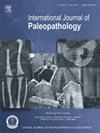Do the regions of the spinal column record stress differently? An analysis of diminished growth in the vertebral neural canal
IF 1.5
3区 地球科学
Q3 PALEONTOLOGY
引用次数: 0
Abstract
Objective
This study explores the validity of the focus on lumbar vertebral neural canal (VNC) diameters as a non-specific stress indicator by comparing evidence of diminished growth between vertebral regions.
Materials
Cervical, thoracic, and lumbar VNC diameters were measured from 29 children (3–18 years) from the Certosa collection, a documented late 19th century skeletal assemblage.
Methods
Z-scores were calculated for each individual vertebra using published anterior-posterior (APD) and transverse (TRD) vertebral diameters obtained from radiographic images of living children. Differences in mean APD and TRD z-scores between vertebral regions were assessed using Repeated Measures ANOVA.
Results
Cervical TRD growth reduction was significantly greater than in the lumbar (p ≤ 0.001) and thoracic regions (p ≤ 0.001), which did not differ significantly (p = 0.524). Mean lumbar APD values were lower than cervical values, but not significantly (F[1,20]=2.259, p = 0.148).
Conclusions
Contrary to current methodological practices, cervical vertebrae TRD showed more diminished growth than thoracic and lumbar vertebrae, while analysis of cervical APD indicates that these vertebrae may be as informative about non-specific stress as lumbar vertebrae.
Significance
An exclusionary focus on lumbar vertebrae could overlook growth insults recorded by the earlier developing cervical vertebrae. This article demonstrates the benefit of reevaluating past research and methodological practices in paleopathology.
Limitations
The use of comparative data from living children may not be applicable to growth in non-surviving children. Magnification may impact the comparability of data from radiographs with manual measurements.
Suggestions for Further Research
Future research using comparative data from magnification-free sources and including the thoracic APD is advised.
脊柱区域记录的应力是否不同?椎神经管生长减少的分析
目的本研究通过比较椎体区域间生长减少的证据,探讨腰椎神经管(VNC)直径作为非特异性应激指标的有效性。材料测量了来自Certosa收集的29名儿童(3-18岁)的颈椎、胸椎和腰椎的VNC直径,Certosa收集了19世纪晚期的骨骼组合。方法采用活体儿童x线影像公布的椎体前后径(APD)和横向径(TRD)计算每个椎体的z -score。采用重复测量方差分析(Repeated Measures ANOVA)评估椎体区域间平均APD和TRD z-score的差异。结果颈椎TRD生长减少显著大于腰椎(p ≤ 0.001)和胸椎(p ≤ 0.001),差异无统计学意义(p = 0.524)。腰椎APD平均值低于颈椎APD平均值,但差异无统计学意义(F[1,20]=2.259, p = 0.148)。与目前的方法实践相反,颈椎TRD比胸椎和腰椎表现出更多的生长减少,而颈椎APD的分析表明,这些椎骨可能与腰椎一样提供非特异性应激的信息。对腰椎的排除性关注可能忽略了早期发育的颈椎所记录的生长损伤。这篇文章展示了在古病理学中重新评估过去的研究和方法实践的好处。使用在世儿童的比较数据可能不适用于非在世儿童的生长情况。放大率可能会影响x光片数据与人工测量数据的可比性。进一步研究建议建议未来的研究使用非放大源的比较数据并包括胸部APD。
本文章由计算机程序翻译,如有差异,请以英文原文为准。
求助全文
约1分钟内获得全文
求助全文
来源期刊

International Journal of Paleopathology
PALEONTOLOGY-PATHOLOGY
CiteScore
2.90
自引率
25.00%
发文量
43
期刊介绍:
Paleopathology is the study and application of methods and techniques for investigating diseases and related conditions from skeletal and soft tissue remains. The International Journal of Paleopathology (IJPP) will publish original and significant articles on human and animal (including hominids) disease, based upon the study of physical remains, including osseous, dental, and preserved soft tissues at a range of methodological levels, from direct observation to molecular, chemical, histological and radiographic analysis. Discussion of ways in which these methods can be applied to the reconstruction of health, disease and life histories in the past is central to the discipline, so the journal would also encourage papers covering interpretive and theoretical issues, and those that place the study of disease at the centre of a bioarchaeological or biocultural approach. Papers dealing with historical evidence relating to disease in the past (rather than history of medicine) will also be published. The journal will also accept significant studies that applied previously developed techniques to new materials, setting the research in the context of current debates on past human and animal health.
 求助内容:
求助内容: 应助结果提醒方式:
应助结果提醒方式:


